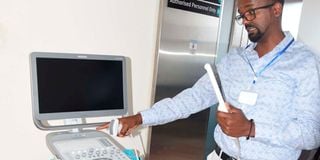New technology improving endometriosis diagnosis

Dr Joseph Njagi explains how the endometriosis ultrasound scan operates at 3rd Park Hospital in Nairobi on February 1, 2023.
What you need to know:
- The new technology, brought into the country early this year, has seen 80 patients undergo free ultrasound scans to diagnose endometriosis.
- Through the technology, doctors now know what to look out for, can tell the stage of the disease, advise the patients and plan the treatment or surgery. They are able to follow up on how patients are responding to treatment, follow up on their fertility and make decisions of referrals.
Dr Rachel Kariuki lay in bed in a hospital gown, waiting to be wheeled into the theatre at At 3rd Park Hospital, Nairobi. It was February 2, 2023, the day endometriosis surgeons were going to open up her belly, prod her ovary to remove cells that were menstruating even though she had removed her uterus a year before.
Calm and soft spoken, she recalls how she found out she had endometriosis. Before the diagnosis, her navel started swelling only when she was on her periods. The swelling was chocolate brown.
“It was painful, but a kind of sweet pain. When the periods ended, the pain lessened, but the swelling remained. With time, I realised that the pain would increase in intensity when I had my periods. The swelling also got bigger, so much so I could also feel its mushy contents around the wall of my tummy,” narrates Dr Kariuki.
At some point during her periods, the swelling burst and released dark brown blood. She would later realise that that was menstrual blood, “and it appeared like I was menstruating through my navel”.
“I knew little about endometriosis because I was a general practitioner. However, I associated it with laparoscopic surgeries I had undergone because in such a procedure, you have to go through the navel to the uterus. I had them (laparoscopic surgeries) when they were diagnosing me with infertility and there was a time they removed a fibroid. I thought that during that process they must have transferred some cells from the uterus to the navel, but many years had already passed,” she explains.
While her navel bothered her, her heavy periods topped up the trouble. Not planning to get another child, her gynaecologist had advised her to remove her uterus, a surgery that she wanted to delay.
“But then I realised that I had to take medicines to boost my blood and I didn’t want to live on medicines. So my uterus was removed and my navel removed and reconstructed by a plastic surgeon. After that life was good. There were no periods,” she narrates.
The discomfort would recur monthly, but without a uterus, she didn’t know whether it was ovulation pain or the body mimicking her past menstrual periods. She, however, noted that every time she experienced the discomfort, her bowel got irritated and she felt a constant need to pass urine. The discomfort would disappear after a few days.
Even though endometriosis has been linked to infertility, Dr Kariuki does not attribute her primary infertility to the condition because she had not been diagnosed. She had gotten married aged 24 and only got a baby eight years later through in-vitro-fertilisation(IVF). Besides, she never had painful periods, a complaint often expressed by people who suffer from the condition.
Dr Joseph Njagi, an obstetrician-gynaecologist at 3rd Park Hospital and founder of Laparoscopy Mashinani, explains that the main challenge with endometriosis is diagnosis and treatment. In a success story, he explains that the newly available advanced ultrasound scanning for diagnosis of endometriosis is an answered prayer for endometriosis patients and specialists.
The new technology, brought into the country early this year, has seen 80 patients undergo free ultrasound scans to diagnose endometriosis, with three surgeries, including Dr Kariuki’s, being conducted.
Dr Njagi explains that the new technology has also seen endometriosis and other medical specialists get trained on how to use the ultrasound machines to increase the diagnosis and management of a larger number of people suffering or suspecting to have endometriosis.
“Initially we needed to do laparoscopy to confirm the diagnosis of endometriosis, which is invasive. But now with ultrasound scans, there are certain changes we can see in the affected body parts, which can actually suggest that there is endometriosis,” he explains.
He adds that through the technology, doctors now know what to look out for, can tell the stage of the disease, advise the patients and plan the treatment or surgery. They are able to follow up on how patients are responding to treatment, follow up on their fertility and make decisions of referrals.
The ultrasound scan machine sends soundwaves into the body then reflects back as an image or illustration. Already aware of how a normal body organ looks like, any deviation is an indication of an abnormality. The scan only takes about 10 minutes to conduct.
“It’s also about the depth of the tissue and the different consistency that will also give you a suspicion. There are of course other things such as mobility of the tissue. Is it moving? Is it stuck? Where is it stuck? All these are findings that we get that help us draw conclusions. If you have a cyst in the ovary, we will know because the fluid in a normal cyst and that of an endo looks different,” he adds.
Based on findings, he explains that the patients scanned were diagnosed with endometriosis of the bowel, ovary and bladder. The condition can, however, affect the uterus.
Endometriosis cannot become cancerous, but behaves like cancer and sometimes can be worse than cancer. “If you cannot have menses, sexual intercourse, pee without feeling pain, can’t have children, can't pass stool without feeling pain, if you have known all kinds of painkillers and they are not helping. I think that is terrible,” he says.
“In a month, I usually operate on three or four patients whose endometriosis is at advanced stages. If it involves the bowel, you will find that either everything is stuck together or they have issues of infertility. In a normal abdomen, every organ is on its own. But when you have endometriosis, your organs — uterus, bowel and bladder — adhere to each other. It’s like someone came and plastered them together or poured superglue,” he explains, adding that the youngest endometriosis patient he has ever had operated on was 15-year-old, who wouldn't go to class when on periods, and whose teachers thought was hysterical.
The World Health Organization states that there is currently no known cure for endometriosis and that treatment only focuses on controlling symptoms.
Access to diagnosis and treatment is, however, usually affected by level of income





